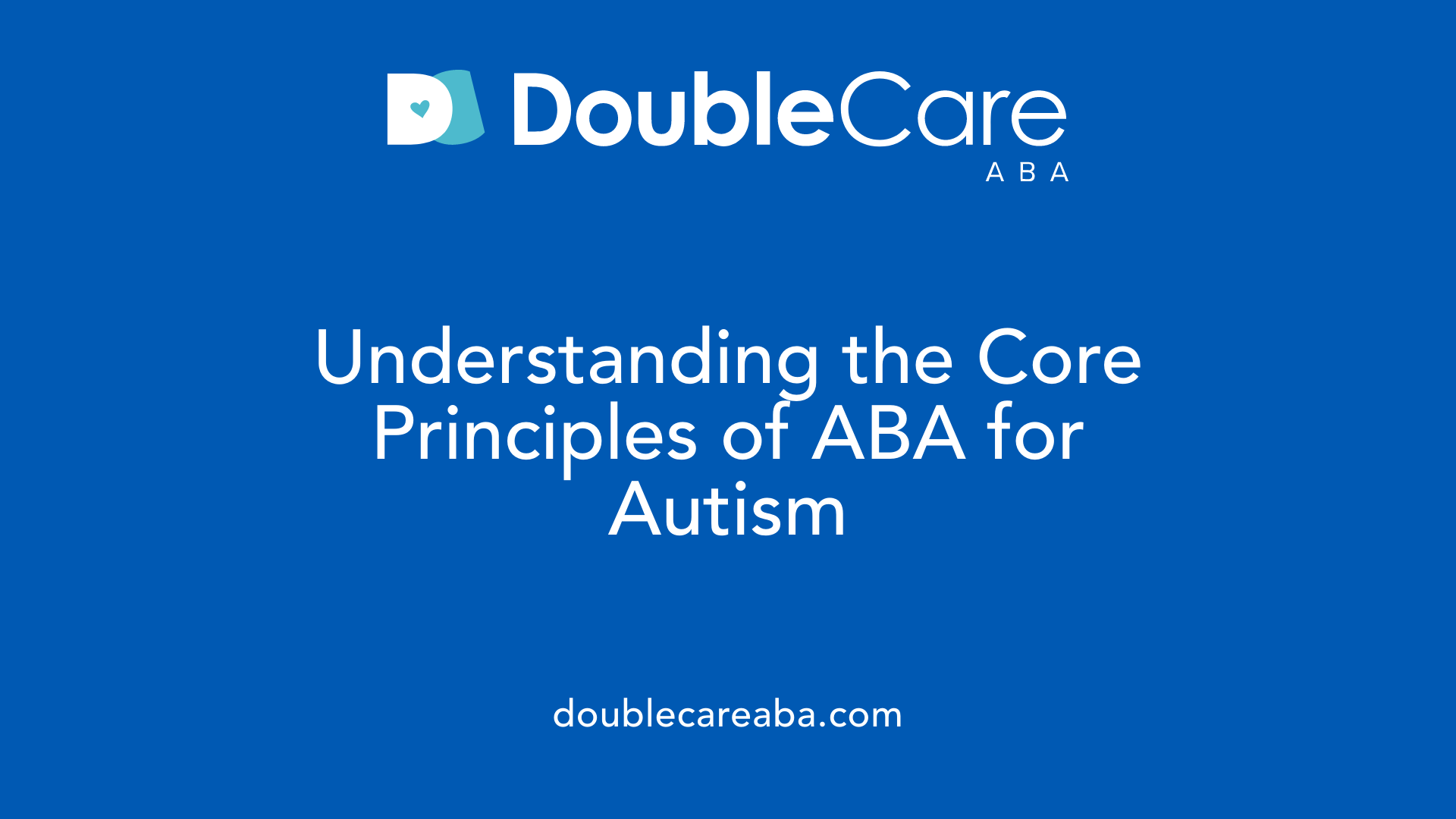How to Use Positive Language When Teaching Kids with Autism
Harnessing the Power of Positive Communication in Autism Therapy

Understanding Positive Language in Autism Education
Teaching children with autism requires strategies tailored to their unique learning profiles. Positive language plays a pivotal role in enhancing communication, social skills, and behavioral outcomes. This article explores how to effectively use positive language within the framework of Applied Behavior Analysis (ABA) therapy, spotlighting methods and benefits drawn from evidence-based practices.
The Foundation of Behavioral Analysis Therapy for Autism

What is the focus of therapy for autism based on behavioral analysis?
Behavioral analysis therapy for autism centers on understanding and modifying behaviors through a structured examination of the environment and consequences surrounding the behavior. This approach breaks down actions into antecedents, behaviors, and outcomes to identify why a behavior occurs and how it can be changed.
The main goal is to foster the development of valuable skills such as communication, social interaction, personal care, and everyday functioning. Equally important is the reduction of harmful or interfering behaviors that may hinder learning or social integration.
Principles of behavioral analysis
Behavioral analysis relies heavily on the use of reinforcement strategies. Positive reinforcement, for instance, rewards desired behaviors to increase their likelihood, while negative reinforcement removes unpleasant stimuli to encourage behavioral change. This scientific approach emphasizes a consistent, supportive learning environment tailored to the child’s developmental level and learning style.
Individualized therapy goals
Therapy is highly personalized, with trained professionals like board-certified behavior analysts (BCBAs) crafting programs that suit each child's unique needs. These interventions focus on enhancing social skills, communication, and essential life skills such as grooming and daily activities. By addressing individual challenges and strengths, therapy maximizes meaningful progress.
Emphasis on communication and social skills
At its core, ABA therapy aims to improve how children with autism engage with the world around them. Through techniques including discrete trial training, naturalistic teaching, and visual supports, children learn to communicate more effectively and navigate social situations with greater independence. This focus not only improves language abilities but also fosters emotional regulation and readiness for real-world interactions.
Positive Reinforcement: The Cornerstone of Effective Communication

What is Positive Reinforcement and Its Purpose?
Positive reinforcement is a foundational technique in ABA therapy that involves rewarding desired behaviors to increase their likelihood of occurring again. In the context of autism therapy, it serves to encourage communication and social interaction by positively responding to these efforts.
How Does Positive Reinforcement Encourage Desired Behavior?
When a child with autism successfully uses a word, gesture, or social skill, providing an immediate and meaningful reward motivates them to repeat that behavior. This encouragement strengthens their communication abilities and supports social engagement.
Examples of Positive Reinforcement in Teaching Social and Communication Skills
- Praising a child for making eye contact during a conversation.
- Offering a favorite toy or activity after the child uses a new word appropriately.
- Using token economies where children earn tokens for participating in group discussions, later exchanging them for preferred items.
These examples demonstrate how positive reinforcement can be seamlessly integrated into therapy and daily routines to enhance learning and interaction.
Benefits Over Other Reinforcement Methods
Compared to negative reinforcement or extinction techniques, positive reinforcement creates a supportive and motivating environment. It fosters emotional regulation and reduces frustration by focusing on rewarding success rather than punishing mistakes, making it especially effective in nurturing communication skills.
In sum, positive reinforcement is a scientifically proven strategy within ABA therapy that promotes meaningful behavioral changes. Its use not only improves communication but also builds confidence and independence in children with autism.
Using Visual Supports and Modeling to Enhance Language Development
Role of visual modeling in ABA
Visual modeling is a powerful ABA technique that uses images, charts, and videos to teach children with autism essential skills. It helps by providing clear, concrete examples that children can imitate, making abstract concepts easier to grasp.
Examples like picture schedules and charts
Common visual supports include picture schedules that outline daily routines and emotion charts that help children recognize and communicate their feelings. These tools support understanding and predictability.
Modeling of behaviors and language
In ABA therapy, professionals demonstrate desired behaviors and language use, encouraging children to imitate these actions. Modeling teaches social skills, communication, and daily living routines in an engaging, memorable way.
How visual aids reduce anxiety and aid comprehension
Visual supports reduce anxiety by clarifying expectations and promoting routine adherence. They create a structured learning environment that eases transitions and makes social situations less overwhelming for children with autism.
Overall, combining visual modeling with other ABA strategies enhances language development by making learning accessible, motivating, and less stressful for children with ASD.
Incorporating Prompting, Fading, and Behavior Chaining for Skill Acquisition
What prompting and fading involve
Prompting in ABA therapy refers to providing cues or assistance to help a child initiate or complete a desired behavior. These prompts can be verbal, gestural, or physical and act as helpful guides during learning. Fading is the gradual removal of these prompts over time. The goal of fading is to encourage the child to perform behaviors independently without relying on external cues.
Behavior chaining for complex tasks
Behavior chaining breaks down complex tasks into smaller, manageable steps taught sequentially. Each step is learned and reinforced before moving to the next, allowing the child to build their skills progressively. This approach is especially effective for teaching daily living activities, such as dressing or grooming, where multiple actions must be performed in a specific order.
How these ABA techniques build independence
By combining prompting, fading, and behavior chaining, ABA therapy supports children in moving from needing full assistance to completing tasks autonomously. Prompting ensures correct task performance initially, while fading gradually reduces support, reinforcing independent skill use. Behavior chaining organizes tasks logically, ensuring mastery of each component before combining them, fostering confidence and self-sufficiency.
Application in teaching daily living skills
These techniques are widely applied to essential life skills like personal hygiene, grooming, and daily routines. For example, a therapist might use prompting to guide a child through handwashing, then fade prompts as the child learns each step. Behavior chaining would help break this process into steps like turning on the tap, applying soap, rinsing, and drying hands. This systematic approach helps children with ASD acquire independence in practical, everyday activities.
Naturalistic and Child-Led Approaches to Foster Spontaneous Communication

What Are Incidental Teaching and Pivotal Response Training?
Incidental teaching and Pivotal Response Training (PRT) are two naturalistic, child-led ABA techniques that promote spontaneous communication. Incidental teaching uses everyday moments as teaching opportunities, allowing children to learn language skills naturally and in context. PRT encourages motivation and social interactions by following the child's interests and choices, making learning more engaging and relevant.
How Is Learning Embedded in Everyday Activities?
Both approaches embed learning into typical routines and play, rather than relying solely on structured sessions. For example, a simple snack time can become a chance to practice requesting items or expressing preferences. This strategy connects language and social skills directly with the child’s environment, enhancing generalization and practicality.
How Do These Methods Enhance Motivation and Engagement?
By allowing children to lead the activity and select topics of interest, these methods increase intrinsic motivation. Reinforcement is immediate and meaningful, rewarding communication attempts naturally—like receiving a favorite toy or social praise—encouraging children to keep practicing and developing.
What Is the Connection with Positive Language Use?
These naturalistic approaches reinforce positive language by modeling correct communication and providing prompts as needed. Over time, prompts are faded, enabling children to communicate independently. This fosters not only vocabulary growth but also social-emotional skills and expressive language in authentic scenarios.
| Technique | Key Features | Benefits for Communication Development |
|---|---|---|
| Incidental Teaching | Uses everyday moments as teachable opportunities | Enhances context-based language use and generalization |
| Pivotal Response Training | Child-led, motivation-focused, social interaction | Increases spontaneous communication and engagement |
By integrating learning seamlessly into daily life and respecting the child’s interests, these naturalistic ABA methods nurture ongoing, spontaneous communication skill development.
The Role of Parents and Caregivers in Reinforcing Positive Language
How does parental involvement benefit children undergoing ABA therapy?
Parental involvement plays a crucial role in enhancing the effectiveness of ABA therapy. When parents and caregivers actively participate, they help build communication and social skills, foster independence, and reduce anxiety and frustration for children with autism spectrum disorder (ASD). This continuous reinforcement at home creates a consistent learning environment, accelerating progress and supporting the generalization of skills beyond therapy sessions.
How can parents use positive reinforcement at home?
Parents can reinforce positive behaviors by rewarding their child’s desired actions with preferred items or engaging activities. This technique encourages children to repeat those behaviors, facilitating better communication and social interactions. Consistent positive reinforcement is essential to motivating children and nurturing their development.
What techniques like conversation, modeling, and prompting can parents utilize?
Several effective strategies that parents can incorporate include:
- Conversation exercises: Engaging children in daily talk to encourage expressive language use.
- Modeling: Demonstrating appropriate social and communication behaviors for the child to imitate.
- Prompting: Offering cues or reminders to initiate correct responses, followed by gradual fading to foster independence.
These techniques make learning interactive and tailored to each child's pace and needs.
How can everyday items and play support therapy at home?
Using common household items and regular toys like puzzles, blocks, dolls, or toy cars can effectively support therapy goals. These familiar materials promote skill-building through natural play activities such as sorting, role-playing, and movement games. Play-based learning not only makes therapy more engaging but also helps children practice language and social skills in meaningful contexts, bridging therapy with daily life.
Practical Classroom Strategies Centered on Positive Language and ABA Techniques

How is ABA applied in educational settings?
ABA therapy is effectively integrated into classrooms to enhance socially significant behaviors, communication, social skills, and learning abilities. It involves modifying the classroom environment to promote appropriate behaviors and understanding the motivations behind student actions. Consistent application of reinforcement and consequences helps shape positive student behaviors.
What techniques like token economy and Discrete Trial Teaching are used?
Key ABA techniques in classrooms include:
- Token Economy: Students earn tokens for positive behaviors, which they can later exchange for rewards. This motivator encourages consistent good behavior.
- Discrete Trial Teaching (DTT): This structured teaching method breaks down skills into small, manageable steps, using prompts and reinforcements to support learning.
- Naturalistic Teaching and Pivotal Response Treatment: These approaches focus on learning within natural settings and encourage spontaneous social interactions.
- Contingent Observation: Observing and reinforcing appropriate behaviors helps students understand expectations.
How can ABA reduce student stress and foster positive behavior?
Training teachers in ABA techniques helps create a structured, predictable, and supportive classroom atmosphere. Reducing ambiguity and increasing control through clear expectations, visual supports, and consistent reinforcement lowers student anxiety. Positive behavior support strategies teach coping mechanisms, which further reduce behavioral challenges.
How are teachers trained in positive communication strategies?
Teachers receive behavior analysis training to effectively use reinforcement, consequences, and communication strategies that promote prosocial behaviors. This training equips educators to implement ABA techniques confidently, fostering stronger teacher-student relationships and improving classroom dynamics. Emphasis is placed on positive language, modeling appropriate behaviors, and reinforcing communication skills.
| Strategy | Description | Classroom Benefit |
|---|---|---|
| Token Economy | Reward system using tokens for positive behavior | Increases motivation and engagement |
| Discrete Trial Teaching | Step-by-step skill instruction with prompts and reinforcement | Effective for teaching foundational skills |
| Positive Behavior Support | Environment modification and coping skill teaching | Reduces behavioral challenges and stress |
| Teacher ABA Training | Teaching ABA principles and communication strategies to educators | Enhances intervention consistency and outcomes |
Building Lasting Communication Skills Through Structured and Supportive Language

Discrete Trial Training for language skills
Discrete Trial Training (DTT) is a highly structured ABA technique designed to build language skills step-by-step. It breaks down complex language abilities—such as vocabulary, sentence structure, and conversation—into small, manageable tasks. Each trial involves a clear instruction, a prompt if needed, a response from the child, and immediate reinforcement for correct answers. This methodical approach helps children with autism master communication skills in an organized and measurable way.
Functional Communication Training to replace challenging behaviors
Functional Communication Training (FCT) focuses on teaching children appropriate ways to communicate instead of using problematic behaviors. When a child learns to express needs with words, gestures, or other communicative methods, disruptive behaviors often decline. FCT supports the development of practical communication skills that serve everyday needs, improving interaction with others and reducing frustration.
Social stories and script fading for social interaction
Social stories and script fading are tools used in ABA therapy to help children navigate social situations. Social stories explain expected behaviors and routines clearly, preparing children for interactions and reducing anxiety. Script fading gradually decreases reliance on verbal or written guides, encouraging spontaneous and independent social communication. Together, these techniques build confidence and social fluency.
Long-term benefits of positive behavioral interventions
Positive behavioral interventions, including reinforcement strategies, contribute to sustained improvements beyond therapy sessions. These methods enhance social engagement, emotional regulation, and readiness for independence in real-world settings. By fostering meaningful communication and coping skills, ABA therapy promotes lifelong benefits in social and daily living domains, helping children with autism lead fuller, more connected lives.
Harnessing Positive Language for Transformative Outcomes
Employing positive language within ABA therapy provides a strong foundation for children with autism to develop crucial skills in communication, social interaction, and independence. By combining scientific methods such as positive reinforcement, visual supports, and naturalistic teaching with active parent and teacher involvement, therapy becomes a nurturing, effective process. This approach not only reduces behavioral challenges but also empowers children to thrive socially and functionally in their daily lives, unlocking their potential through encouragement and structured learning.
References
- 6 Benefits of ABA Therapy for Children with Autism
- ABA Techniques: Strategies for Behavior Analysts - GSEP Blog
- How ABA Therapy Can Support Language Development in ...
- ABA Therapy Techniques to Support Children's Growth
- Behavioral Therapy Activities For Autism
- How to Use ABA in the Classroom
- Applied Behavior Analysis (ABA)
















